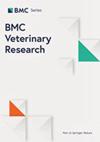Prevalence, risk factors, and characterisation of extended-spectrum β-lactamase -producing Enterobacterales (ESBL-E) in horses entering an equine hospital and description of longitudinal excretion
IF 2.6
2区 农林科学
Q1 VETERINARY SCIENCES
引用次数: 0
Abstract
Extended-spectrum β-lactamase -producing Enterobacterales (ESBL-E) are important zoonotic pathogens that can cause serious clinical infections, also in horses. Preventing the spread of ESBL-E, especially in the equine hospital environment, is key to reducing the number of difficult-to-treat infections. Estimating the local prevalence of ESBL-E in horses is crucial to establish targeted infection control programs at equine hospitals. We conducted a prevalence and risk factor study in equine patients on admission to an equine teaching hospital in Finland through a rectal ESBL-E screening specimen of the horse and a questionnaire. The prevalence of ESBL-E in admitted horses was 3% (5/161, 95% CI 1–7%); none of the tested factors remained statistically significant in multivariate analysis, although antimicrobial treatment within three months was borderline significant (p = 0.052). Extended-spectrum β-lactamase -producing Klebsiella pneumoniae ST6179:CTX-M-15 was detected in three horses using whole-genome sequencing, which in combination with patient records suggested nosocomial transmission. Escherichia coli isolates were ST1250:CTX-M-1 (n = 1), ST1079:CTX-M-1 (n = 1), and ST1245:CTX-M-14 (n = 1). Multiple virulence genes were detected in the ESBL-E isolates. In the ESBL-E positive horses enrolled in a one-year follow-up study, ESBL-E were unlikely to be isolated in rectal screening specimens after the initial positive specimen. The prevalence of ESBL-E in horses visiting a veterinary teaching hospital in Finland is low, indicating an overall low prevalence estimate in the country’s equine population. No statistically significant risk factors were identified, likely due to the low number of cases. The duration of ESBL-E carriage is likely to be very short in horses.进入马医院的马匹中产广谱β-内酰胺酶肠杆菌(ESBL-E)的流行率、风险因素和特征,以及纵向排泄描述
产广谱β-内酰胺酶肠杆菌(ESBL-E)是重要的人畜共患病原体,可引起严重的临床感染,也可引起马匹感染。防止 ESBL-E 的传播,尤其是在马医院环境中的传播,是减少难以治疗的感染数量的关键。估计ESBL-E在当地马匹中的流行率对于在马医院制定有针对性的感染控制计划至关重要。我们通过马匹直肠ESBL-E筛查标本和问卷调查,对芬兰一家马科教学医院的入院马匹患者进行了流行率和风险因素研究。入院马匹的 ESBL-E 感染率为 3% (5/161, 95% CI 1-7%);在多变量分析中,尽管三个月内的抗菌治疗具有边缘显著性 (p = 0.052),但所有检测因素均无统计学意义。通过全基因组测序,在三匹马身上检测到了产广谱β-内酰胺酶的肺炎克雷伯氏菌ST6179:CTX-M-15,结合患者的记录,这表明该病菌是通过院内传播的。大肠埃希菌分离物为 ST1250:CTX-M-1(n = 1)、ST1079:CTX-M-1(n = 1)和 ST1245:CTX-M-14(n = 1)。在ESBL-E分离株中检测到多种毒力基因。在为期一年的随访研究中,ESBL-E阳性马匹的直肠筛查标本中,ESBL-E不太可能在最初的阳性标本之后分离出来。在芬兰一家兽医教学医院就诊的马匹中,ESBL-E的流行率较低,这表明该国马匹的总体流行率较低。由于病例数量较少,没有发现具有统计学意义的风险因素。马匹携带ESBL-E的时间可能很短。
本文章由计算机程序翻译,如有差异,请以英文原文为准。
求助全文
约1分钟内获得全文
求助全文
来源期刊

BMC Veterinary Research
VETERINARY SCIENCES-
CiteScore
4.80
自引率
3.80%
发文量
420
审稿时长
3-6 weeks
期刊介绍:
BMC Veterinary Research is an open access, peer-reviewed journal that considers articles on all aspects of veterinary science and medicine, including the epidemiology, diagnosis, prevention and treatment of medical conditions of domestic, companion, farm and wild animals, as well as the biomedical processes that underlie their health.
 求助内容:
求助内容: 应助结果提醒方式:
应助结果提醒方式:


